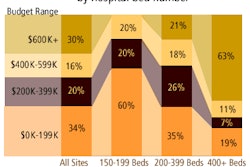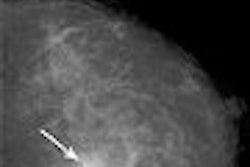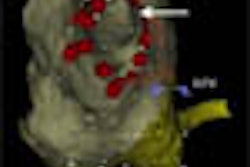If your facility performs endovascular repair of aortic aneurysms, prepare for new and revised Current Procedural Terminology (CPT) codes in 2006.
Endovascular repair is the use of an endoprosthesis to seal off abnormal sections of the aorta. Endovascular repair of the abdominal aorta has had its own Category I codes for several years, but repair of the thoracic aorta has had only Category III codes (0033T-0040T). On January 1 of this year, however, new Category I codes for the thoracic aorta procedures took effect.
The new code definitions include endovascular repair of any abnormality of the descending thoracic aorta, including both disease (for example, aneurysm) and trauma. The repair is categorized according to whether the endoprosthesis covers the origin of the left subclavian artery (thus blocking blood flow into the subclavian). Coverage of the subclavian may be necessary if there is not enough normal aorta below the subclavian to securely hold the top edge of the prosthesis.
Repair with left subclavian coverage
The following codes are used to report endovascular repair of the descending thoracic aorta with coverage of the left subclavian origin:
33880: Endovascular repair of descending thoracic aorta (for example, aneurysm, pseudoaneurysm, dissection, penetrating ulcer, intramural hematoma, or traumatic disruption); involving coverage of left subclavian artery origin, initial endoprosthesis plus descending thoracic aortic extension(s), if required, to level of celiac artery origin.
75956: Endovascular repair of descending thoracic aorta (for example, aneurysm, pseudoaneurysm, dissection, penetrating ulcer, intramural hematoma, or traumatic disruption); involving coverage of left subclavian artery origin, initial endoprosthesis plus descending thoracic aortic extension(s), if required, to level of celiac artery origin, radiological supervision, and interpretation.
Codes that replace Category III codes 0037T, 0038T
The following new codes have been added for bypass grafting in conjunction with endovascular repair:
33889: Open subclavian to carotid artery transposition performed in conjunction with endovascular repair of descending thoracic aorta, by neck incision, unilateral. Code 33889 replaces Category III code 0037T.
33891: Bypass graft, with other than vein, transcervical retropharyngeal carotid-carotid, performed in conjunction with endovascular repair of descending thoracic aorta, by neck incision. It is used to report bypass grafting between the left common carotid and left subclavian, which is performed so that blood entering the carotid can also supply the subclavian circulation. Code 33891 is used to report a bypass graft from the right common carotid to the left common carotid.
Repair without left subclavian coverage
The following codes are used to report endovascular repair of the descending thoracic aorta without coverage of the left subclavian origin, replacing Category III codes 0034T and 0039T:
33881: Endovascular repair of descending thoracic aorta (for example, aneurysm, pseudoaneurysm, dissection, penetrating ulcer, intramural hematoma, or traumatic disruption); not involving coverage of left subclavian artery origin, initial endoprosthesis plus descending thoracic aortic extension(s), if required, to level of celiac artery origin.
75957: Endovascular repair of descending thoracic aorta (for example, aneurysm, pseudoaneurysm, dissection, penetrating ulcer, intramural hematoma, or traumatic disruption); not involving coverage of left subclavian artery origin, initial endoprosthesis plus descending thoracic aortic extension(s), if required, to level of celiac artery origin, and including radiological supervision and interpretation. If the initial prosthesis is placed distal to the subclavian origin but a proximal extension that covers the subclavian is added, the procedure should be reported with 33880 instead of 33881. Endovascular repair of thoracic aortic aneurysm (codes 33880 and 33881) includes placement of distal extensions.
Placement of a distal extension at a subsequent encounter should be reported with the following codes:
33886: Placement of distal extension prosthesis(s) delayed after endovascular repair of descending thoracic aorta.
75959: Placement of distal extension prosthesis(s) delayed after endovascular repair of descending thoracic aorta, as needed, to level of celiac origin; including radiological supervision and interpretation.
Endovascular repair does not include placement of proximal extensions, which should be reported separately using the following new codes:
33883: Placement of proximal extension prosthesis for endovascular repair of descending thoracic aorta (for example, aneurysm, pseudoaneurysm, dissection, penetrating ulcer, intramural hematoma, or traumatic disruption); initial extension.
+33884: Each additional proximal extension is listed separately in addition to code for the primary procedure.
75958: Placement of proximal extension prosthesis for endovascular repair of descending thoracic aorta (for example, aneurysm, pseudoaneurysm, dissection, penetrating ulcer, intramural hematoma, or traumatic disruption); including radiological supervision and interpretation. If a proximal extension is needed, it must be passed up through the main prosthesis in a collapsed state and then expanded once it is in place. Codes 33883 and 75958 are reported for placement of the initial proximal extension. If additional proximal extensions are placed, codes 33884 and 75958 should be reported for each additional extension.
As with endovascular repair of the abdominal aorta, thoracic aorta procedures require separate coding for vascular access, including open exposure of the femoral, iliac, or brachial artery. For 2006, the existing codes 34833 (iliac artery exposure with conduit) and 34834 (brachial artery exposure) have been revised so they can be used for thoracic as well as abdominal aorta repair. Codes 34812 and 34820 did not require revision.
By Jackie Miller
AuntMinnie.com contributing writer
March 7, 2006
This article originally appeared in the "Radiology Administrator's Compliance & Reimbursement Insider," a monthly newsletter published by HC Pro that is designed specifically for radiology administrators. For a free trial subscription, please click here.
Miller is a senior consultant with healthcare coding service firm Coding Strategies of Powder Springs, GA.
Related Reading
CPT code released for breast MRI CAD, January 10, 2006
New CPT code set for RFA, November 23, 2005
Understanding the new codes for cardiac CT, November 21, 2005
Coding for the back shouldn't be a pain, November 8, 2005
New CPT codes set for coronary CT angiography, July 26, 2005
Copyright © 2006 HC Pro



















